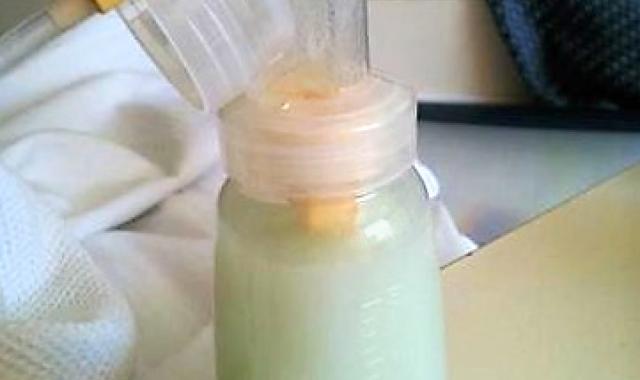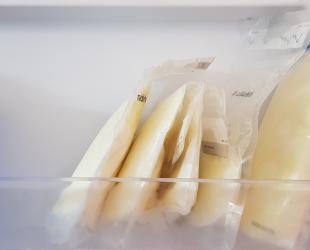Breastmilk looking or smelling a little strange?
It’s common and usually nothing to worry about.

Most mums aren't aware of the colour of their breastmilk unless they express. If your breastmilk looks different from how you expected it would, you might be concerned.
The colour of breastmilk varies. Colostrum is typically yellowish and mature breastmilk is typically bluish-white. However, there is a wide range of normal.
Sometimes your breastmilk may change colour because of your diet, often from food dyes in foods or drinks.
Unusual colours of breastmilk
can be caused by eating a large amount of strongly-coloured foods such as beetroot. It can also sometimes indicate blood staining. See below under ‘Blood in breastmilk’.
In rare cases, a bright or 'fluoro' pink colour can develop when expressed breastmilk is stored. If you aren't expressing, you may notice bright pink breastmilk stains on breast pads or cloths that you use to catch leaking milk, or in your baby's nappies. These bright pink stains can sometimes be seen when a common bacterium called Serratia marcescens grows. Talk to your doctor if you notice these signs. They can check that you and your baby are well and offer treatment if needed. If you are expressing, take extra care to clean your expressing equipment (including bottles) well and ensure you store and prepare your milk safely.
can be caused by eating a large amount of orange-coloured foods such as carrots or pumpkin.
can be caused by eating large amounts of green (or even blue) coloured foods such as green vegetables, kelp and other types of seaweed in tablet form or concentrates of natural vitamins. Blue dyes in foodstuffs sometimes cause breastmilk to be green-tinged.
can be caused by some medications (eg oral Minocycline therapy for acne). It can also indicate blood staining. See ‘Blood in breastmilk' below.
usually means blood or broken-down blood products. See ‘Blood in breastmilk’ below.
are often just the cream that naturally rises to the top of the milk once it sits in a container for any length of time.
In most cases, the colour of your breastmilk is nothing to be worried about. However, check with your doctor or child health nurse if you’re concerned.
Blood in breastmilk
In most cases, blood staining in breastmilk does not indicate a serious medical condition (eg breast cancer), but you should see a doctor to check.
Bright red, pink, coffee/chocolate brown, black or olive-green coloured breastmilk may mean there is some blood. The most common cause of blood in breastmilk is a cracked nipple. A less common condition is an intraductal papilloma — a small benign wart-like growth on the lining of a milk duct, which bleeds. This is not breast cancer and usually goes away in a few days. It is still a good idea to check with your doctor.
It’s common to have blood-stained colostrum or milk in the first days after giving birth. This is referred to as 'rusty pipe syndrome'. Scientists think it’s due to the growth of the ducts and milk-making cells in the breast. It goes after about 7 days.
Occasionally a baby may have dark poos or may spit up blood-stained milk. This is usually because they have drunk blood-stained breastmilk rather than the blood coming from the baby. It often looks like a lot of blood because the blood can form one large lump in the stomach, which they then spit up.
Swallowed blood won’t harm your baby but tends to irritate the stomach and baby might vomit it up. However, it's good to check with your doctor in those situations.
My breastmilk smells or tastes different
Your breastmilk may occasionally smell like the food you have eaten (eg garlic). This is one of the good things about breastfeeding. Your baby is learning about the flavours in your family diet even before they start solids!
It’s also possible that food smells from your fridge/freezer or storage containers have been absorbed into the stored breastmilk. As long as your breastmilk has been stored correctly, it is quite safe to use.
Some mums notice that their expressed milk has an ‘off’ or soapy smell and taste, even when they have handled it cleanly. This can be caused by oxidation following the normal action of enzymes in the milk designed to help the baby digest the milk fats. This problem doesn't make the milk unsafe. Most babies don’t notice, but some may refuse to drink it. The change can’t be fixed once it has happened but you can scald your milk as soon as you express it to stop it happening.
To scald your breastmilk, heat until close to boiling (not in the microwave) then cool it quickly by placing the container into a bowl or sink of ice and water. Then store your milk as usual. Only scald your milk if your baby has refused to drink it due to the taste, as scalding destroys some of the immune factors in your milk.
© Australian Breastfeeding Association July 2023
Beckerman, J. P., Slade, E., & Ventura, A. K. (2020). Maternal diet during lactation and breast-feeding practices have synergistic association with child diet at 6 years. Public Health Nutrition, 23(2), 286–294.
Eglash, A., Simon, L., & Academy of Breastfeeding Medicine. (2017). ABM Clinical Protocol #8: Human milk storage information for home use for full-term infants, revised 2017. Breastfeeding Medicine, 12(7), 390–395.
Quinn, L., Ailsworth, M., Matthews, E., Kellams, A., & Shirley, D. A. (2018). Serratia marcescens colonization causing pink breast milk and pink diapers: A case report and literature review. Breastfeeding Medicine, 13(5), 388–394. https://doi.org/10.1089/bfm.2018.0002
Spahn, J. M., Callahan, E. H., Spill, M. K., Wong, Y. P., Benjamin-Neelon, S. E., Birch, L., Black, M. M., Cook, J. T., Faith, M. S., Mennella, J. A., & Casavale, K. O. (2019). Influence of maternal diet on flavor transfer to amniotic fluid and breast milk and children’s responses: A systematic review. American Journal of Clinical Nutrition, 109(Suppl_7), 1003S–1026S.
Spitzer, J., Doucet, S., & Buettner, A. (2010). The influence of storage conditions on flavour changes in human milk. Food Quality and Preference, 21(8), 998-1007.
Tang, H., Zhu, W., Chen, J., & Zhang, D. (2022). Rusty pipe syndrome: A case report and review of the literature. BMC Pregnancy and Childbirth, 22(1), 770.


